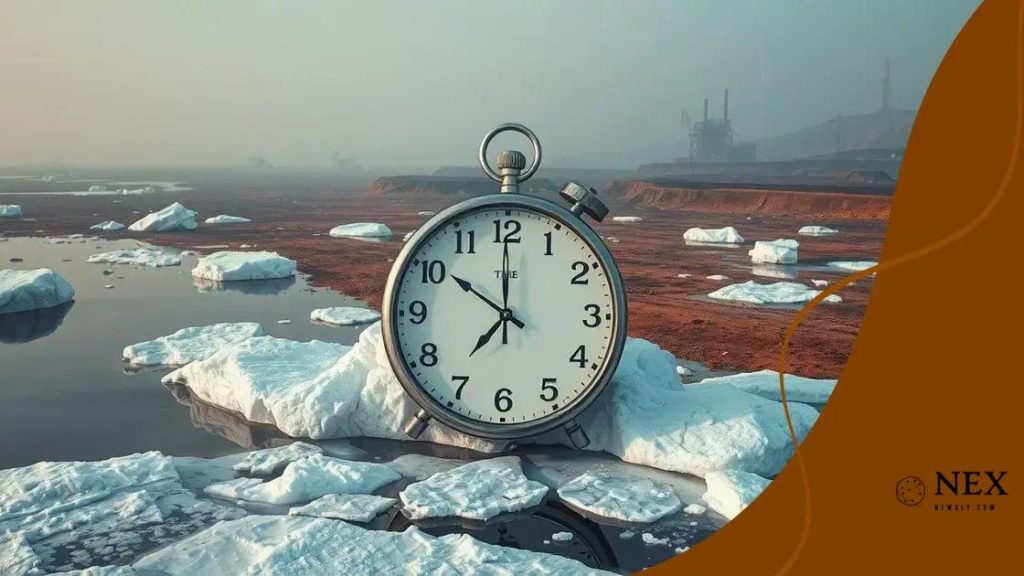Climate action delay: why we can’t afford to wait

Anúncios
Climate action delay refers to the postponement or lack of necessary initiatives to combat climate change, resulting in severe environmental, economic, and health consequences that necessitate urgent policy changes and individual contributions.
Climate action delay poses a significant threat to our environment and future generations. Are we truly prepared to face the consequences of waiting? Let’s dive into the pressing need for immediate action.
Anúncios
Understanding the causes of climate action delay
Understanding the causes of climate action delay is crucial for addressing the urgent need for change. By exploring these causes, we can better grasp why action is often postponed. Let’s take a closer look.
Economic Factors
One significant reason for the delay in climate action is related to economic concerns. Many industries fear that investing in sustainable technologies will increase costs. This hesitation often leads to continued reliance on fossil fuels, which exacerbate climate problems.
- Short-term profit over long-term sustainability.
- Lack of funding for green projects.
- Economic instability causing hesitation to invest.
Additionally, the complexities of shifting economies toward greener options can be overwhelming for businesses. They may struggle to see how immediate changes will lead to future benefits.
Anúncios
Political Inertia
Political systems also play a crucial role in delaying climate action. Policymakers can be reluctant to prioritize environmental issues, especially when facing pressure from lobbyists and special interest groups. This often results in policies that do not effectively address climate change.
Furthermore, the shifting political landscapes can lead to abrupt changes in priorities. Upcoming elections, for example, may direct focus away from long-term climate strategies.
Public Awareness and Misinformation
Many people lack a clear understanding of climate science. Misleading information and media sensationalism contribute to confusion. As a result, there is often a disconnect between public opinion and the urgency of the climate crisis.
- Inconsistent messages about climate issues.
- Confusion about scientific consensus.
- Resistance from groups denying climate change.
To tackle this, it’s essential to educate the public about the realities of climate change. Better-informed citizens are likely to advocate for swift action.
Technological Limitations
While technology can provide solutions, delays in development and implementation can stall progress. Emerging technologies sometimes face setbacks, preventing them from being deployed in time to effectively address the climate crisis.
The gaps in infrastructure to support new technologies can also contribute to delays. For instance, vast investments are often needed to maintain old systems while integrating new ones.
Ultimately, understanding these underlying causes reveals the challenges we face. Every delay allows climate issues to worsen, impacting our planet and future generations. Addressing these causes requires collaboration at all levels.
The consequences of inaction on climate change
The consequences of inaction on climate change are becoming increasingly severe. As we delay needed actions, the impacts on our planet and society intensify. Key issues arise in various sectors, affecting all of us.
Environmental Impacts
One of the most visible consequences is the degradation of our environment. Our forests, oceans, and wildlife habitats suffer. Ecosystems collapse under pressure, which leads to loss of biodiversity. Additionally, natural disasters grow more common and severe, harming communities worldwide.
- Increased frequency of extreme weather events.
- Rising sea levels threatening coastal areas.
- Loss of species and critical ecosystems.
Such environmental shifts affect food and water supplies, driving shortages and conflict.
Economic Costs
Inaction also leads to significant economic costs. Natural disasters and resource shortages burden our economic systems. Companies face losses due to disrupted supply chains and infrastructure damage. Governments struggle to fund recovery efforts while attempting to address the underlying causes of climate change.
- High costs associated with disaster recovery.
- Increased insurance costs for homes and businesses.
- Job losses in climate-sensitive industries.
Ultimately, these challenges can stifle economic growth and development, hitting vulnerable populations the hardest.
Health Risks
Delayed climate action increases health risks for communities. Air and water quality decline, leading to health complications. Heatwaves and pollution contribute to respiratory issues, while food scarcity can lead to malnutrition.
Vulnerable populations, such as the elderly and low-income families, face the highest risks. Access to healthcare can become strained as more people require treatment for climate-related illnesses.
Addressing these consequences is crucial. Understanding the impact of inaction on climate change helps stress the need for immediate solutions. While the challenges may seem daunting, proactive measures can significantly reduce the negative effects of climate change.
Successful case studies of timely climate action

Successful case studies of timely climate action illustrate how proactive measures can lead to positive outcomes. These examples show us that taking action can result in a healthier planet and stronger communities.
Renewable Energy Adoption
Several countries have made remarkable progress by transitioning to renewable energy sources. For instance, Denmark has invested heavily in wind energy, generating nearly 47% of its electricity from wind turbines. This commitment has not only reduced carbon emissions but has also created thousands of jobs in the renewable energy sector.
- Investing in wind and solar energy technologies.
- Encouraging community-owned renewable energy projects.
- Promoting government policies that favor green energy.
This success demonstrates that renewable energy can power economies while combating climate change.
Urban Sustainability Initiatives
Cities across the globe have implemented sustainability initiatives that significantly lower emissions. For example, San Francisco launched its zero waste program, aiming to divert 100% of waste from landfills. By encouraging recycling and composting, the city has reduced its landfill waste by more than 80%.
This successful model showcases how urban areas can lead the way in effective waste management by engaging citizens and promoting sustainable practices.
Forest Conservation Efforts
Another impressive case is the efforts of Costa Rica in forest conservation. The country developed programs to pay landowners for maintaining and reforesting their land. Since the 1980s, Costa Rica has doubled its forest cover, preserving biodiversity and supporting local economies.
- Implementing payment for ecosystem services programs.
- Engaging local communities in conservation efforts.
- Promoting eco-tourism to benefit from a preserved environment.
These examples emphasize that investing in nature is a viable strategy for both environmental health and economic stability.
With these successful case studies, we see not just the viability of climate action, but the benefits that can arise from timely decisions. Engaging with these successful models can inspire others to take meaningful steps towards a sustainable future.
How individuals can contribute to climate efforts
Individuals play a key role in addressing climate change through their actions and choices. Every small effort counts and contributes significantly to overall climate efforts. Let’s explore various ways individuals can make a difference.
Reducing Energy Consumption
One effective method is to reduce energy consumption at home. Simple actions like turning off lights when leaving a room and unplugging devices can lead to substantial savings in energy use. Additionally, using energy-efficient appliances helps lower electricity bills while decreasing carbon emissions.
- Switching to LED bulbs for lighting.
- Utilizing smart thermostats to optimize heating and cooling.
- Practicing mindful energy use throughout the day.
By making these adjustments, individuals contribute to a collective reduction in energy demand.
Embracing Sustainable Transportation
Another impactful way to contribute is by embracing sustainable transportation options. Walking, biking, carpooling, or using public transport reduces the number of cars on the road, which decreases greenhouse gas emissions.
For longer distances, consider choosing electric or hybrid vehicles. These options are not only better for the environment but often come with incentives that make them financially attractive.
Supporting Sustainable Products
Buying sustainable products also helps combat climate change. When individuals choose local foods, organic products, and eco-friendly items, they support businesses that prioritize sustainability.
- Shopping at local farmers’ markets.
- Opting for products with minimal packaging.
- Choosing brands with strong environmental commitments.
These purchases encourage more companies to adopt sustainable practices and reduce their carbon footprints.
Additionally, getting involved in local community efforts strengthens climate action. Joining environmental groups or participating in community clean-up events fosters collective action and raises awareness. Engaging with others not only amplifies individual efforts but also inspires more people to take action.
By incorporating these strategies into daily life, individuals can drive meaningful change in the fight against climate change. Every effort, no matter how small, contributes to a larger impact.
Policy changes needed to accelerate climate action
Policy changes are essential to accelerate climate action and address the urgent challenges posed by climate change. Current regulations often fail to meet the scale of the crisis we face. Therefore, it is crucial to explore what changes can lead to meaningful progress.
Strengthening Renewable Energy Policies
One significant policy change is the support for renewable energy sources. Governments can provide incentives for businesses and homeowners to invest in solar, wind, and other sustainable technologies. By increasing subsidies and tax breaks, more people are likely to transition to green energy.
- Creating feed-in tariffs to guarantee prices for renewable energy.
- Setting ambitious renewable energy targets.
- Funding research and development in clean technologies.
These measures can help shift the energy market toward sustainable options, decreasing reliance on fossil fuels.
Implementing Carbon Pricing
Another critical policy shift involves implementing carbon pricing. By putting a price on carbon emissions, businesses will have a financial incentive to reduce their carbon footprint. This shift encourages innovation in green technologies and sustainable practices.
- Introducing carbon taxes that reflect the true cost of emissions.
- Establishing cap-and-trade systems to limit overall emissions.
- Utilizing generated revenue for environmental projects.
Such approaches can effectively lower emissions while promoting economic growth and job creation in the green sector.
Enhancing Environmental Regulations
Strengthening environmental regulations also plays a vital role. Stricter regulations on industries that contribute heavily to pollution can lead to significant reductions in harmful emissions. For instance, enforcing limits on emissions from vehicles and factories can improve air quality and public health.
By prioritizing sustainable practices in business operations, governments can foster an environment where economic activities do not come at the expense of the planet.
Additionally, increasing transparency in corporate environmental impacts can pressure companies to adopt better practices. Policies that encourage proper reporting of emissions and sustainability measures can drive corporations to be more accountable.
To tackle climate change effectively, these policy changes must be prioritized and implemented urgently. A collaborative approach among governments, industries, and communities will pave the way for a sustainable future.
FAQ – Frequently Asked Questions about Climate Action
What are some ways individuals can help combat climate change?
Individuals can help by reducing energy consumption, using sustainable transportation, and supporting eco-friendly products.
Why is policy change important for environmental action?
Policy changes create stronger regulations and incentives that encourage businesses and communities to adopt sustainable practices.
How does carbon pricing work?
Carbon pricing assigns a cost to carbon emissions, encouraging companies to lower their emissions to avoid higher costs.
What are the benefits of renewable energy?
Renewable energy reduces greenhouse gas emissions, creates jobs, and decreases reliance on fossil fuels, leading to a cleaner environment.





